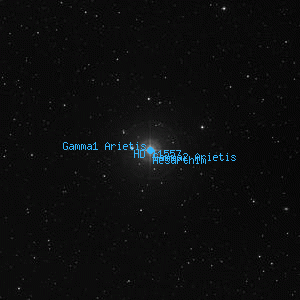Mesarthim

Overlaid DSS image of Mesarthim, 60' x 60' with north at top and west to the right
Aladin viewer for the region around Mesarthim
Gamma Arietis, γ Ari, 5 Ari
BD+18 243, WDS J01535+1918, HIP 8832
BD+18 243, WDS J01535+1918, HIP 8832
| Type | Binary Star |
|---|---|
| Magnitude | 3.86 | Right Ascension | 1h 53' 31.8" (2000) |
| Declination | 19° 17' 38" N |
| Constellation | Aries |
| Description | Binary 4.58/4.64 7.6" @ 0° |
Observing Notes
Andrew Cooper
Oct 24, 2020 Waikoloa, HI (map)
20cm f/6 Newtonian, Cave Astrola @ 76x
Seeing: 7 Transparency: 6 Moon: 25%
A lovely binary with two almost equally bright blue-white stars, well separated at 7.4", while the stars apper equal at first glance further inspection shows the northern γ1 Ari to be about a few tenths magnitude fainter than the southern γ2 Ari, the pair is set in a pretty field with several 8-10th magnitude stars including the 8.5 magnitude HD11557 4' east
Andrew Cooper
Oct 22, 2016 Kaʻohe, Mauna Kea, HI (map)
51cm f/4 Newtonian, Obsession #004 @ 169x
Seeing: 7 Transparency: 6 Moon: 0%
A nice binary in Aries, naked eye visible, two well matched 4.5/4.5 magnitude blue-white stars, easily split at 170x
Captain William Henry Smyth
Dec 6, 1837 No. 6 The Crescent, Bedford, England (map)
150mm f/17.6 refractor by Tully 1827
A neat double star, the duplicity of which was discovered by Dr. Hook, in 1664. A 4½, bright white; and B 5, pale grey. This fine object is formed by Piazzi's Nos. 196 and 197, Hora 1, and is placed at the lower bend of the Ram's horn, where it precedes β and α; it is followed in the nf, but nearly on the parallel, and about 3'.5 distant, by the 9th-magnitude star which that astronomer describes. A and B are H 9 III., and these are the results of the earliest recognition of them as a pair; with reductions from the Palermo Catalogue:H. Pos. 356°05' Dist. 10".17 Ep. 1779.68From observations made by William Herschel twenty-three years afterwards, he concluded the orbital angle to have increased; but the subsequent measures of H. S. Σ. D. and myself, indicate little or no change. It is certainly a beautiful pair, in a powerful instrument. " "What would Cassini say," demands Herschel, "if he were to view the first star of Aries, which appeared to him as split in two, through a telescope that will show η Corona Borealis, and h Draconis to be double stars?"
P. 360°00' 8".90 1800
[WDS 1° 7".40 2020]
The larger member of this compound has these proper motions in space:P.... RA +0".15 Dec. -0".12Dr. Hook mentions that the telescope shows some stars, which appear single, to consist of two or more, so close, that to the naked eye both the images falling upon one single filament of the tunica retinæ, make but one impression upon the brain. "Of this kind," he continues, "the most remarkable is the star in the left horn of Aries, which, whilst I was observing the comet which appeared in the year 1664, and followed till he passed by this star, I took notice that it consisted of two small stars very near together: a like instance to which I have not else met with in all the heaven." There are some thousands now detected!
B.... +0".10 +0".09
[Gaia DR2 +0".078110 -0".097499]
γ Arietis has been called the first star in Aries, because it was once the nearest to the equinoctial point: it was named Mesartim, owing to an erroneous deduction by Bayer from the word Sartai, a corruption of Al Sharataïn, which is the next star.― A Cycle of Celestial Objects Vol II, The Bedford Catalogue, William Henry Smyth, 1844
Other Data Sources for Mesarthim
Associated objects for Mesarthim
Nearby objects for Mesarthim
5 objects found within 60'
| Gamma1 Arietis | Gamma2 Arietis | HD 11557 |
| IC 1736 | NGC 719 |
Credits...
Drawings, descriptions, and CCD photos are copyright Andrew Cooper unless otherwise noted, no usage without permission.
A complete list of credits and sources can be found on the about page
Mesarthim